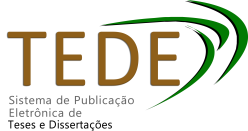| ???jsp.display-item.social.title??? |


|
Please use this identifier to cite or link to this item:
http://localhost:8080/tede/handle/tede/197| ???metadata.dc.type???: | Tese |
| Title: | MULTISCALE INVERSION OF ONSHORE-OFFSHORE ELECTROMAGNETIC DATA FROM SOUTHEAST BRAZIL AND SANTOS BASIN |
| ???metadata.dc.creator???: | SANTOS BENEVIDES, ARTUR |
| ???metadata.dc.contributor.advisor1???: | FONTES, SERGIO LUIZ |
| ???metadata.dc.description.resumo???: | Neste trabalho, foram utilizados os métodos magnetotelúricos (MT) e eletromagnéticos de fonte controlada (CSEM) para avaliar a natureza geoelétrica rasa e profunda da Terra sob a margem terrestre do sudeste brasileiro e a bacia offshore adjacente de Santos (SB). Os cinturões orogênicos do Brasília Sul e Ribeira (BROB) e a litosfera subjacente da SB foram investigadas através de imagens MT tridimensionais usando 174 conjuntos de dados MT anfíbios. Modelos de condutividade 3D revelam a presença de uma crosta altamente heterogênea abaixo do BROB, enquanto é uniformemente resistiva abaixo da região da plataforma continental da SB. Uma camada resistiva segmentada de 60-80 km e outra camada inferior moderadamente resistiva de 80-100 km são características-chave da litosfera. Exceto o acima, um condutor sub-litosférico de mergulho acentuado está associado a uma ascensão astenosférica confinada e pode estar relacionado com deformação superficial das serras do BROB abaixo dos enxames de diques paralelos à costa de São Paulo-Rio de Janeiro. Raízes litosféricas profundas de ~200 km foram encontradas abaixo de parte do BROB, que se adelgaça para ~75 km abaixo da Plataforma continental da SB e provavelmente se torna mais fino em direção ao oceano profundo coincidente com o limite litosfera-astenosfera (LAB) encontrado em estudo de tomografia sísmica, especulando que a abertura do Oceano Atlântico Sul provavelmente elevou a litosfera naquela região. Também foi investigada a relação entre a estrutura crustal profunda e a deformação na cunha sedimentar sob a SB e a evolução do 'Gap do Albiano' relacionado ao sal. Foi encontrado sob essa cunha, que a crosta continental resistiva tem cerca de 35 km de espessura ao longo da linha de charneira cretácica e, em seguida, adelgaça-se em direção ao oceano para ~21 km ao longo de uma distância lateral de ~80 km, definindo um domínio de crosta altamente estendida e falhada. Os modelos MT mostram um alto de embasamento associado ao manto e evidências de significativo deslocamento da badia sedimentar sobrejacente, que coincide espacialmente com o Gap do Albiano, além de um alto da Moho previamente proposto, implicando uma deformação acoplada do embasamento e da cunha sedimentar. É proposto que magmatismo ou o fluxo da crosta inferior possam ter desempenhado um papel significativo no deslocamento inferido no Gap do Albiano. Em uma terceira abordagem desse estudo, é apresentado um fluxo de processamento de dados CSEM a partir de um conjunto de dados reais recentemente disponibilizado na SB, interseccionando o perfil MT principal. Após processamento, uma metodologia envolvendo inversão conjunta de dados MT e CSEM a partir de um esquema prático de ponderação e inserção de vínculos geofísicos também é empregada, resultando em um melhor ajuste de dados e imagens eletromagnéticas aprimoradas que são validadas por considerações geológicas e outros dados geofísicos. |
| Abstract: | In this work, magnetotelluric (MT) and Controlled Source Electromagnetic (CSEM) methods have been used to assess the deep and shallow geoelectrical nature of the Earth underneath Southeastern Brazilian onshore margin and the adjoining offshore Santos basin (SB). It was investigated the Southern Brasilia and Ribeira Orogenic Belts (BROB) and SB underlying lithosphere by three-dimensional MT imaging using 174 amphibious MT dataset. 3D conductivity models reveal the presence of a highly heterogeneous crust in BROB, whereas it is uniformly resistive below the SB continental shelf region. A resistive segmented layer (of about 60-80 km), and another moderately resistive lower layer (of 80-100 km) are key features of the lithosphere. Excepting the above, a steeply dipping sub-lithospheric conductor is associated with a confined asthenosphere upwelling and might be related with the surface deformation hills of BROB below the coast-parallel São Paulo-Rio de Janeiro dyke swarms. Deep lithospheric roots of ~200 km were found beneath part of BROB, which is thinning out to be ~75 km below the SB continental shelf and probably becomes thinner towards the deeper ocean coincident with the lithosphere-asthenosphere boundary (LAB) found in seismic tomography, speculating that the opening of the South-Atlantic Ocean probably uplifted the lithosphere underneath it. It is also investigated the relationship between deep crustal structure and the deformation in the overlying sedimentary wedge in SB and evolution of the salt-related ‘Albian Gap’. It was found beneath this wedge, the resistive continental crust is ~35 km thick across the Cretaceous hinge line and thereafter thins seaward to ~21 km over a lateral distance of ~80 km defining a domain of highly extended and faulted crust. The models show a mantle-associated basement high and evidence of significant dislocation of the overlying sedimentary wedge which spatially coincides with the Albian Gap and a previously proposed Moho high. This implies a coupled deformation of the basement and the sedimentary wedge. It is proposed that magmatism or lower crustal flow may have played a significant role in the inferred displacement at the Albian Gap. Finally, it is presented a CSEM processing workflow from a data set recently public available in SB intesecting the main MT profile. A methodology involving joint inversion of MT and CSEM data incorporating a practical weighting scheme and constraints is also employed resulting in better data fit and enhanced electromagnetic images that are validated through geological considerations. |
| Keywords: | Magnetotelúrico;CSEM;Inversão 3D;Dados EM anfíbio;Sudeste do Brasil |
| ???metadata.dc.subject.cnpq???: | GEOFISICA::GEOFISICA APLICADA |
| Language: | por |
| ???metadata.dc.publisher.country???: | Brasil |
| Publisher: | Observatorio Nacional |
| ???metadata.dc.publisher.initials???: | ON |
| ???metadata.dc.publisher.department???: | Divisão de Programas de Pós-Graduação - DIPPG |
| ???metadata.dc.publisher.program???: | Programa de Pós-Graduação em Geofísica |
| Citation: | SANTOS BENEVIDES, ARTUR. MULTISCALE INVERSION OF ONSHORE-OFFSHORE ELECTROMAGNETIC DATA FROM SOUTHEAST BRAZIL AND SANTOS BASIN. 2023, 142 páginas da Tese do Programa de Pós-Graduação em Geofísica- Observatório Nacional, RJ. |
| ???metadata.dc.rights???: | Acesso Aberto |
| URI: | http://localhost:8080/tede/handle/tede/197 |
| Issue Date: | 13-Dec-2023 |
| Appears in Collections: | Teses de Doutorado PPGG |
Files in This Item:
| File | Description | Size | Format | |
|---|---|---|---|---|
| Artur Santos Benevides.pdf | 72.22 MB | Adobe PDF | Download/Open Preview |
Items in DSpace are protected by copyright, with all rights reserved, unless otherwise indicated.




